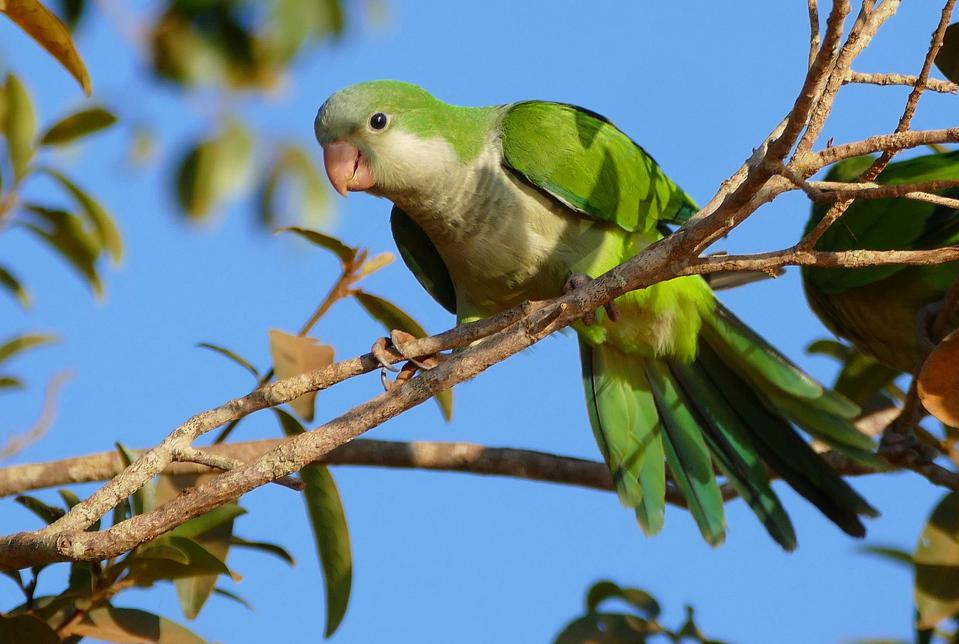The Wild Parrots, er… Parakeets of Rehoboth Beach

By GREGG KIRK
June 1996
In 1993, some friends of mine and I were walking down some side streets to get to the beach in Rehoboth Beach, DE when one of them pointed out a huge nest between the power lines and a telephone pole. It was the biggest and most carelessly-made birds nest I had ever seen, and I started laughing until one of them told me it was one of the wild parrot nests of Rehoboth Beach. According to my friend, apparently enough pet parrots had escaped to form their own little colony in a section of the town. The fact that the birds had survived our climate and seemed to be thriving (judging from the bulging nests) captured my imagination, and I wondered for a few more years how the birds were getting along.
In March of 1994 as I attended the South by Southwest Music Conference in Austin, TX, some friends and I were walking toward the baseball field where the final day’s festivities were being held — a free barbecue and softball game. As we made our way through the field, one of my friends marveled at the gigantic birds nests situated in each of the night-game lamps that surrounded the field. I looked up to see the exact type of nest I had seen three years before in Rehoboth, and feeling like an expert, I related to my friends that these were no doubt pet parrots gone wild.
In June of 1994 I decided to pique my curiosity, so I called Jim White, who is a naturalist at the Ashland Nature Center in Wilmington, DE. As soon as the words “birds nests” and “Rehoboth Beach” left my mouth, Jim responded with, “Oh, you’re talking about the Monk Parakeets in Rehoboth.”
Parakeets? These were no mere parakeets, I assured Jim. These things had HUGE nests and could probably take a full-grown man alive.
“No, no, no, these are lime-green parakeets, not much bigger than a Blue Jay,” Jim assured me back. I was a little let down that these were not the two-foot long parrots I had envisioned, but Jim maintained my intrigue by informing me that these birds had in fact escaped their owners and had formed a colony.
Why are their nests so big?
“Because they are communal birds,” he said. “They are usually seen in flocks in the 20s, and several birds live in one nest.”
Another thing that had interested me was the fact that one of the nests I had seen had been built right next to a humming transformer on a telephone pole. The amount of electro-magnetic radiation that had to have been coursing through that nest boggled my mind, but I figured that the birds had situated it there because of the artificial heat. Jim shot this idea down as well.

“The birds aren’t smart enough to perceive the artificial heat idea,” he said. “If anything, they built it there because the transformer was protecting the nest from the wind.”
Jim also schooled me about a few other things concerning the birds. Apparently they first appeared in Rehoboth in the 1980s. They are assumed to be escaped pet birds that have been sighted in noisy flocks from as far as Broadkill Beach. Their main congregation of nests is on Lake Street (by Silver Lake) in Rehoboth, and they have adapted well to the climate, which is much like their native South American clime. They have been thriving but their numbers have not exploded, which is actually fortunate for the survival of this colony of birds. If their numbers were to increase to the point of causing a negative impact upon the environment, something drastic would have to be done.
“They may not have caused damage yet, but neither did the Starling or English Sparrow,” Jim said. “On the other hand, the Ring-Necked Pheasant has caused no problems, and that’s an exotic species that has been introduced to our environment.”
Uhhh, right. So what would be done?
“They would need to be eliminated,” Jim said. “Or if someone invested a lot of money, they could be captured and transported to South America, but that would be very expensive.”
Eliminated? You mean, like genocide?
“Yeah, well normally when an exotic species becomes naturalized, it is customary to eliminate them, but there are no immediate plans to eliminate these birds,” Jim assured me. “They would have to cause a serious negative impact to have that happen.”
According to Jim there are other colonies of this species across the country — in Chicago, Florida, and yes, Austin, TX, but again, nothing is being done to disturb the birds because they have not disrupted the environment so far.
“I find these birds beautiful and interesting,” Jim said. “But it’s not right that they exist in an environment other than their native environment.”
For more information on the Monk Parakeets of Rehoboth Beach, contact Ashland Nature Center at 302-239-2334 or visit their website: https://www.delawarenaturesociety.org/centers/ashland-nature-center/